A Bright Comet, Appreciating the Moon when Super or Otherwise, Moon Phase Information, and Prominent Planets at Dawn and Dusk!
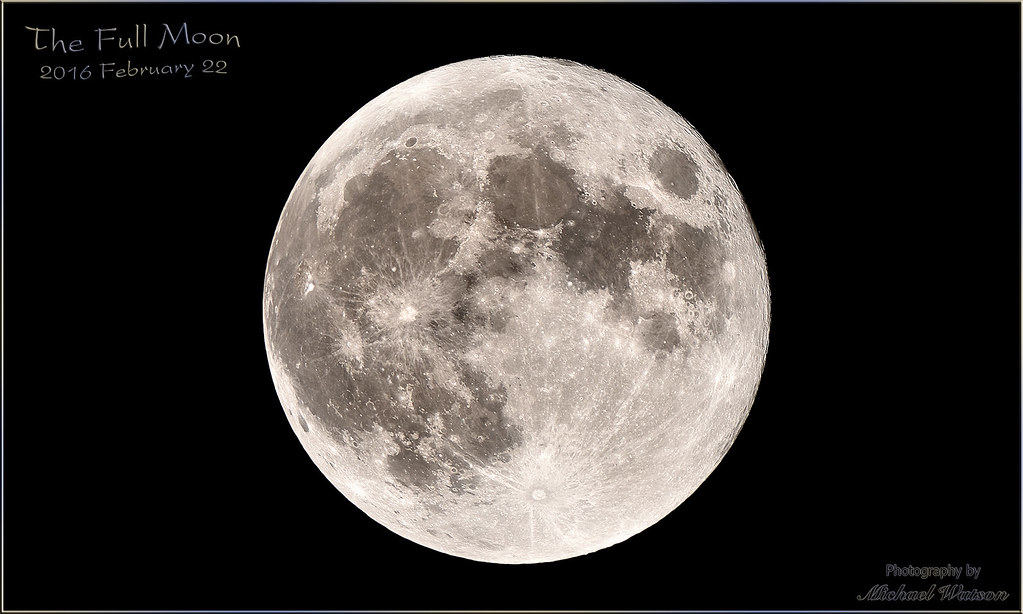
This image of the moon by Michael Watson of Toronto was taken 9 hours after it was full on February 22, 2016 – replicating how the May, 2020 full moon will appear on Thursday night. Note that the moon’s right-hand edge shows some shadowing – evidence that it is slightly past full. The many bright streaks, or rays, are white, highland rock material that has been ejected from the more recent craters. Those features are most visible during the full moon.You can explore all of Michael’s images here.
Hello, May Moon Lovers!
Here are your Astronomy Skylights for the week of May 3rd, 2020 by Chris Vaughan. Feel free to pass this along to your friends and send me your comments, questions, and suggested topics. You can also follow me on Twitter as @astrogeoguy! Unless otherwise noted, all times are expressed in Eastern Time. To subscribe to these emails please click this MailChimp link.
I can bring my Digital Starlab portable inflatable planetarium to your school or other daytime or evening event, or teach a session online. Contact me through AstroGeo.ca, and we’ll tour the Universe or the Earth’s interior together!
A newly discovered comet has reportedly become bright enough to see with unaided eyes. The moon will dominate the night-time sky all over the world this week as it waxes toward, and then passes full, on Thursday morning in the final supermoon of 2020 – so let’s look at what the moon has to offer. Brilliant Venus continues to show a pretty crescent in telescopes after dinner, and the trio of bright planets will shine in the southeast before dawn. Unfortunately, that bright moon will spoil the Eta-Aquariids meteor shower on Wednesday morning. Here are your Skylights!
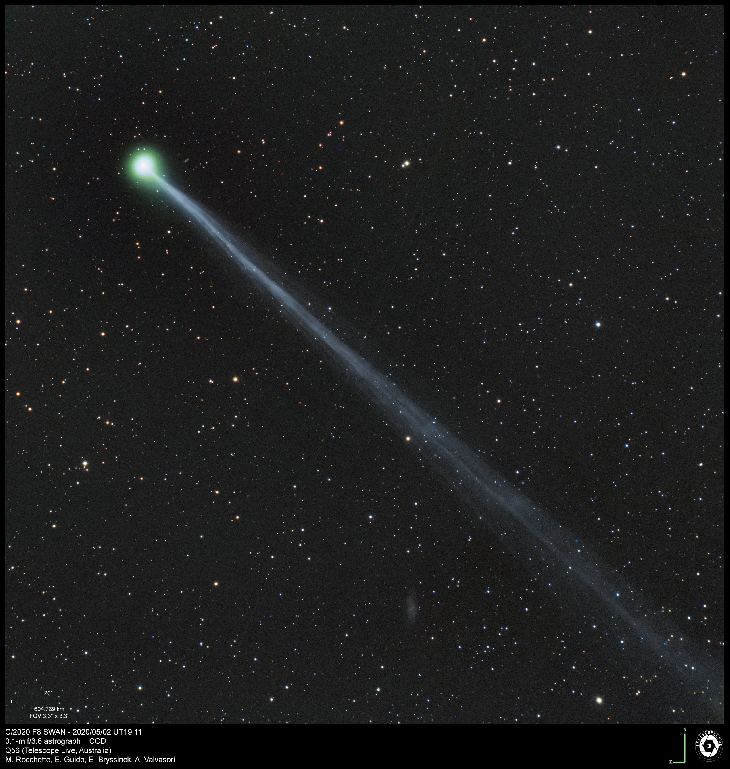
Bright Comet SWAN
A newly discovered comet named c/2020 F8 (SWAN) has reportedly become bright enough to see with unaided eyes (about magnitude of +5.5)! But its orbit is keeping it too low in the sky and too close to the sun for easy viewing by people living at mid-northerly latitudes.
The comet should continue to brighten over the next few weeks – if it doesn’t disintegrate. On May 12 it will make its closest approach to Earth of 0.56 Astronomical Units (that’s about half the average sun-Earth distance). It is predicted to reach a peak brightness of +3 in late May when it swings around to the sun at perihelion.
Look for Comet SWAN sitting low in the eastern pre-dawn sky at around 5 am local time. This week it will travel from northern Cetus (the Whale) and into Pisces (the Fishes). If you live farther south, you’ll have a much easier time seeing it as a greenish fuzzy patch with a faint narrow tail.

The Moon
This week, the moon will dominate evening skies all around the world. Our natural satellite offers plenty of interesting viewing using your unaided eyes, binoculars, and telescopes of any size. So let’s focus on the moon – summarizing its change in appearance, its journey across the sky this week, and some sights to see on it!
Today (Sunday) the moon exhibit an appearance that astronomers call waxing gibbous. The moon spends half of its 29.5 day cycle waxing in phase and the other half waning in phase. The term phase describes the amount of the moon that is illuminated, as viewed from Earth. That latter point is an important aspect to the phenomenon – the moon’s sphere is always half-illuminated by the sun. That lit-up half faces Earth at full moon phase, faces away from Earth and new moon phase, and is sideways to Earth at first and last quarter phases.
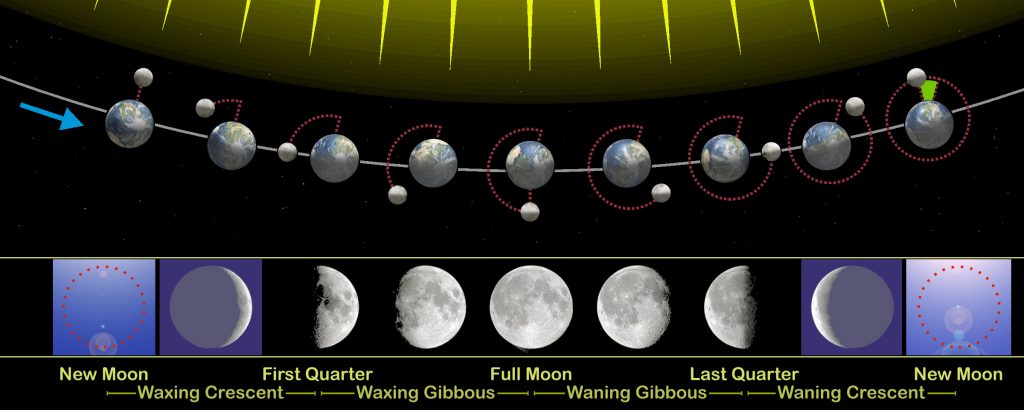
The term waxing means increasing – in this case, in the percent of the moon we see illuminated. The increased Illumination is apparent night after night, but it is also happening minute by minute and hour by hour. (You can view the moon in a telescope early in the evening and then look again an hour or two later and see a difference.) The moon waxes between new moon (not illuminated at all from Earth) and full moon (completely illuminated from Earth), and then it wanes back to new moon. Evening moons are always waxing, while pre-dawn moons are always waning.
When the moon is more than half-illuminated, it’s a gibbous moon. When it is less than half-illuminated, it is a crescent moon. From new moon to first quarter, we see a waxing crescent moon. From first quarter to full moon, we see a waxing gibbous moon. From full moon to last quarter, we see a waning gibbous moon. And from last quarter to new moon, we see a waning crescent moon.
The boundary line that separates the moon’s lit and dark hemispheres runs from the moon’s north pole to its south pole. It’s called the terminator. Mercury and Venus have their own terminators – by the way. By noting the tilt of the lunar terminator, you can see how the moon’s orientation varies as it crosses the sky due to Earth’s diurnal rotation. When the moon rises in the east, its north pole is towards your left (if you are viewing it from the Northern Hemisphere). When it is over the southern horizon, it is vertical. And when the moon sets, its north pole will be tipped towards your right.
I said “today” above because the moon will rise in mid-afternoon, shine prominently during this evening, and set well after midnight. That’s what makes viewing the moon so convenient when it is between first quarter and full. But it rises (and sets) later every day. When we reach Thursday’s full moon, the moon will rise at sunset and set at sunrise. The late sunsets in May and June make full moons shine well after bedtime for youngsters.
Tonight (Sunday) the moon will shine among the modest stars of the Maiden, Virgo. The moon’s orbit will carry it through Virgo for several nights, passing less than a palm’s width from Virgo’s brightest star Spica on Tuesday night. On Wednesday and Thursday, the very bright moon will traverse the dim stars of Libra (the Scales).
The moon will reach its full phase at 6:45 am EDT (or 10:45 Greenwich Mean Time) on Thursday – shortly after it has set in the Eastern Time Zone. And, yes – moon phases can occur at any time of the day or night because the phase of the moon only depends on the angle formed by the sun, Earth, and moon, and not at all on the rotation of the Earth and the people who live on it. As a matter of fact, only in Eastern Asia and Western Australia will this moon be exactly full when it rises. The rest of the world will see the moon a little before or a little after it is full at moonrise.
With the moon’s full phase arriving in early morning on Thursday in the Eastern Time Zone, observers living in that region will see the moon as very slightly less than full on Wednesday night. Binoculars will reveal a thin strip of darkened moon along the moon’s western limb. (That’s the moon’s left side for Northern Hemisphere observers – and the moon’s right side if you live down under.) At a casual glance, the moon will also look completely full on Thursday evening, but it will be missing a sliver of illumination along its eastern (right-hand) limb.
Every culture around the world has developed its own stories about the full moon, and has assigned special names to each full moon. The indigenous Ojibwe groups of the Great Lakes region call the May full moon Zaagibagaa-giizis “Budding Moon” or Namebine-giizis, the “Sucker Moon”. For them it signifies a time when Mother Earth again provides healing medicines. The Cree of North America call it Athikipisim, the “the Frog Moon” – the time when frogs become active in ponds and swamps. The Cherokee call it Ahnisguti, the “the Planting Moon”, when the fields are plowed and sown.
In European cultures, this moon is commonly called the Full Milk Moon, Full Flower Moon, or Full Corn Planting Moon. This full moon will occur about 30 hours after perigee, the point in the moon’s orbit when it is closest to Earth, making this the last of three consecutive supermoons in 2020. I wrote about supermoons here.
Don’t forget that any moon, even a supermoon, can easily be covered by a pinky fingernail held at arm’s length and one eye closed. That even applies to little children’s tiny fingers! By the way the astronomical term for an alignment of three celestial objects is a syzygy – in this case, the sun, Earth, and moon. So this full supermoon will be a lunar perigee syzygy.
On the coming weekend, the waning gibbous moon will rise near midnight and then linger into the eastern pre-dawn sky among the stars of Ophiuchus (the Serpent-Bearer) and Sagittarius (the Archer).
What to See on the Moon
Looking at the moon through binoculars and telescopes this week will show you the tremendous difference in the way sunlight illuminates the moon, and the impact of that. Early in the week, the sun’s rays will be striking the moon from the side – especially along the pole-to-pole terminator line that separates the lit and dark hemispheres where the sun is just rising over the moon’s eastern horizon. With no atmosphere to scatter light, the shadows cast by every crater rim, mountain, and ridge are a deep black – and even very small bumps and ridges are highlighted, revealing otherwise hidden features on crater floors.
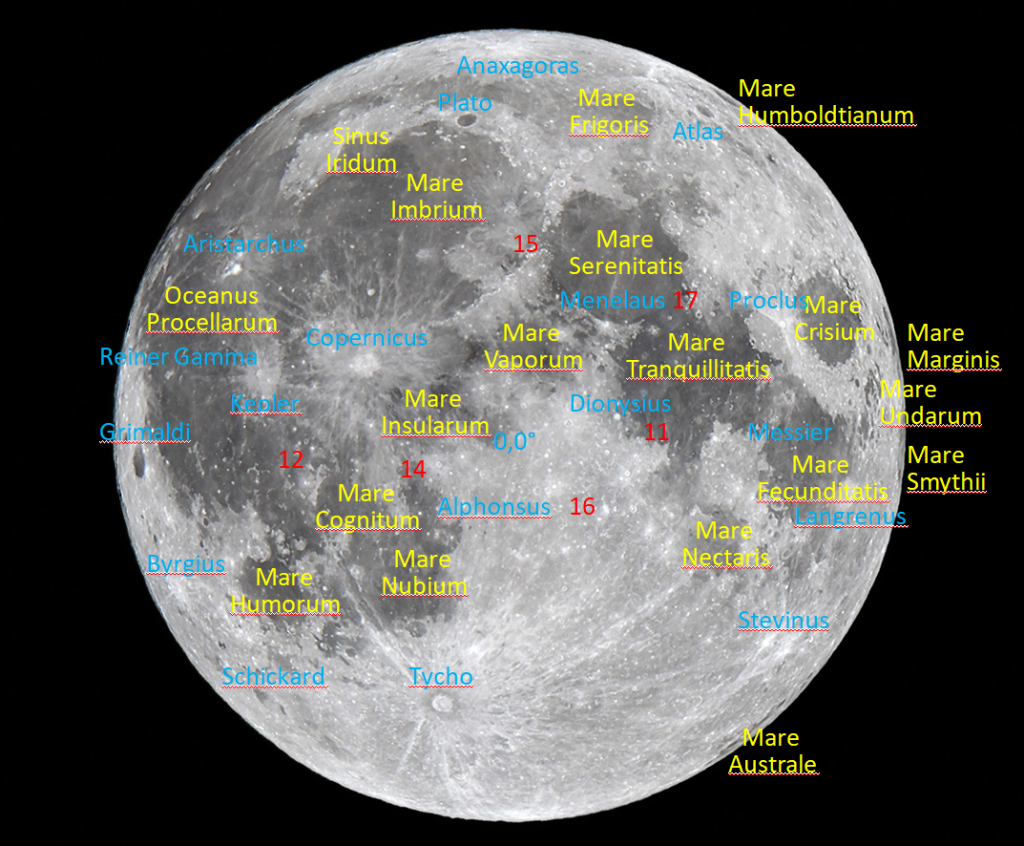
At Thursday’s full moon, however, the moon will be fully illuminated, and the light striking the moon then will be coming from directly “behind you” when you face the full moon – the same way the projector in a cinema lights up the movie screen in front of you. That sunlight is arriving straight-on to the moon’s surface, so it doesn’t generate any shadows. Every variation in brightness and colour you see on a full moon is due entirely to the moon’s geology, not its topography! Now you can easily distinguish the dark, grey basalt rocks from the bright, white aluminum-rich anorthosite rocks.
The basalts overlay the various lunar maria, Latin for “seas” – coined because people used to think they were water-filled. The maria are basins excavated by major impactors early in the moon’s geologic history and later infilled with dark basaltic rock that upwelled from the interior of the moon late in the moon’s geological history.
The much older and brighter parts of the moon are composed of anorthosite rock. Those areas are higher in elevation and are heavily cratered – because there is no wind and water, or plate tectonics, to erase the scars of impacts. By the way, the bright, white appearance is produced by sunlight reflecting off of the crystals the rock is made of – the same sort of crystals you see in the granite countertops in Earth’s kitchens. And yes, there are coloured rocks on the moon.
Some of the violent impacts that created the craters in the highland regions also threw bright streams of ejected material far outward and onto the darker maria. We call those streaks lunar rays. Some rays are thousands of km in length – like the ones emanating from the very bright crater Tycho in the moon’s southern central region.
Use your binoculars to scan around the full moon. There are smaller ray systems everywhere! There are also places where craters punched into the maria have ejected dark rays on to white rocks. And, since the dark basalt overlays the white, older rock below, you can find lots of craters where a hole has been punched through the dark rock, producing a white-bottomed crater!
Several of the maria link together to form a curving chain across the northern half of the moon’s near-side. Mare Tranquillitatis, where humanity first walked upon the moon, is the large, round mare in the centre of the chain. You can plainly see that this mare is darker and bluer than the others, due to its basalt being enrichment in the mineral titanium. That’s one of the reasons why Apollo 11 was sent to that location.
By the way, Earth-bound telescopes – even the largest ones – cannot see the items left by the astronauts on the moon. When the air is particularly steady, the smallest feature you can see on the moon with your backyard telescope is about 2 to 6 km across – far larger than a lunar module descent stage. Only the cameras on spacecraft in orbit around the moon can photograph astronauts’ footprints, lunar rover tracks, and equipment.
The Planets

This week, our sister planet Venus, the very bright, star-like object sitting part-way up the western sky after sunset, is still shining at close to its maximum brightness. The planet will be setting shortly before midnight in your local time zone. Viewed through a telescope, Venus will show a nice, large disk in the shape of a slim crescent. If you want to see Venus’ less-than-fully-illuminated disk, aim your telescope at the planet as soon as you can pick it out of the darkening sky. In a twilit sky, Venus’ out-of-round shape will be more apparent. And, when Venus is higher in the sky you’ll be viewing the planet more clearly – through less of Earth’s distorting atmosphere. The medium-bright star sitting about two finger widths above (or 2.5° to the celestial east of) Venus is Elnath, the northern horn tip of Taurus, the Bull. Venus is moving closer to that star every night.
On Monday, Mercury will pass the sun in superior conjunction. By the end of this week, Mercury will return to view in the west-northwestern sky for a short time after sunset. Mercury will be very well positioned for viewing during the second half of May.

In the southeastern pre-dawn sky this week, the three bright planets Jupiter, Saturn, and Mars form a line more than 2.5 fist diameters in length along the ecliptic. Bright, white Jupiter rises first at about 1:45 am local time. Dimmer, yellowish Saturn will rise about 15 minutes later, and then reddish Mars will round out the trio – rising after 3 am. All three planets will remain visible in the lower part of the sky until almost sunrise – with brighter Jupiter hanging on a bit longer than the other two. During the week, Mars will continue to increase its distance from the two gas giant planets. Telescope owners can look for the dim fuzzy patch of the globular star cluster known as Messier 75 sitting just 1.5 finger widths below and between Jupiter and Saturn.
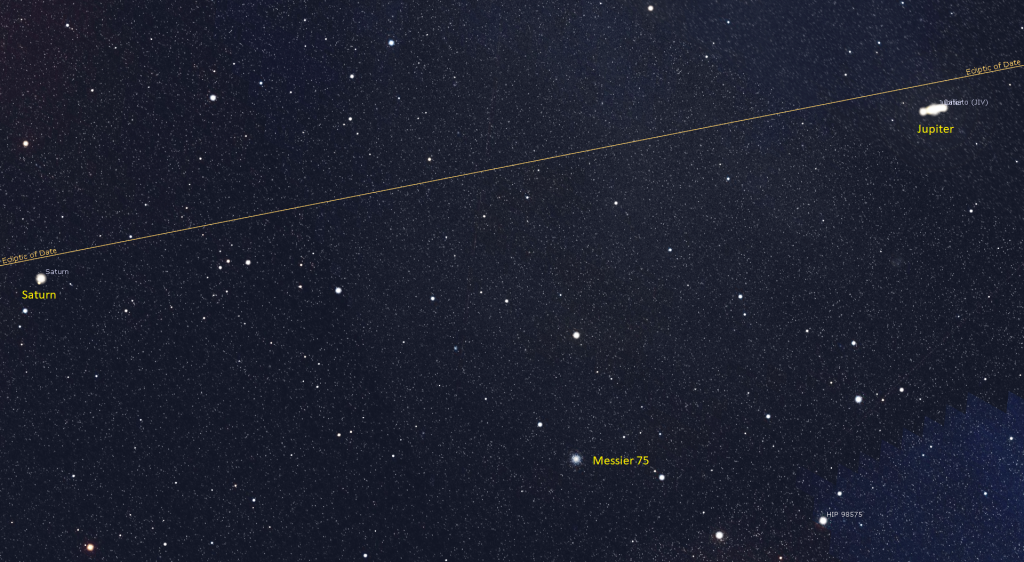
In the Eastern time zone, Jupiter’s Great Red Spot will be crossing the planet’s disk on Tuesday morning, Friday morning, and Sunday morning. Jupiter’s moon Io will cast its small, round, black shadow on Jupiter on Wednesday morning, May6 between 3 am and 5:15 am EDT.
For those keeping score, the dim outer planets Uranus and Neptune are in the pre-dawn eastern sky – but they are too close to the sun, or too low in the sky, to observe easily right now. I’ll post sky charts for all the observable planets here.
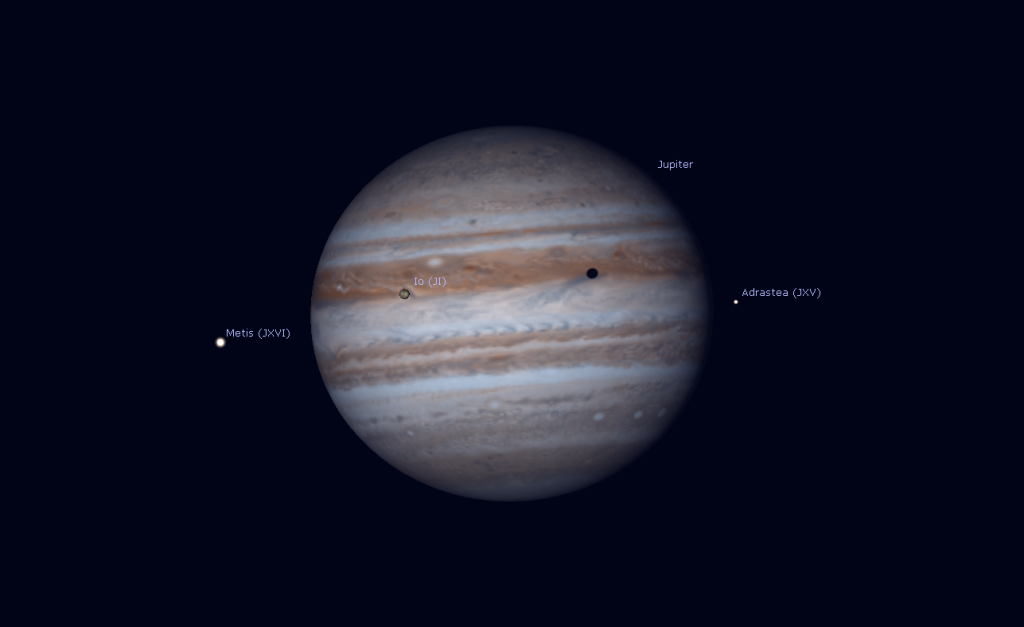
Eta-Aquariids Meteor Shower Peak
The annual Eta-Aquariids Meteor Shower is produced by particles of material left behind by passages of Halley’s Comet. The shower, which runs from April 19 to May 26, will peak in intensity before dawn on Wednesday, May 6. The paths of Aquariids meteors will extend away from a radiant point in Aquarius (the Water-Bearer), which will lie near the southeastern horizon. That’s what gives this shower its name. The southerly radiant makes this shower better for observers at low latitudes. Normally during the peak, up to a few dozen meteors per hour can be seen, including some fireballs. But the bright, nearly full moon in the sky on the peak morning will drastically reduce the number of meteors you see.
Public Astro-Themed Events
Due to the COVID-19 virus, in-person public star parties and lectures have been cancelled or postponed for the moment. Here are some Internet-based astro-themed activities.
My Insider’s Guide to the Galaxy live, daytime astronomy broadcasts are geared towards families, in partnership with the Royal Astronomical Society of Canada. They’ll continue on Tuesday, May 5 at 3:30 pm EDT with all about beginner telescopes. I hope you’ll join me and my co-host Jenna Hinds, the terrific Youth Coordinator at RASC National. Future topics and the Zoom link to sign up are all here. You can also watch the sessions on the RASC’s YouTube channel in real time, or later on. The past sessions are all posted there, too.
On Wednesday evening, May 6 at 7 pm, the Perimeter Institute in Waterloo will present a YouTube webcast by theoretical cosmologist and science communicator Katie Mack — known to her many Twitter followers as @astrokatie. She will answer questions about her favourite subject: the end of the universe. Details are here.
On Friday evening, May 8 at 7 pm EDT, RASC National member Heather Laird will deliver an online talk about Canadian Women in Astronomy. For more information and the link to register for the Zoom session, click here. Or watch it live, or later, on YouTube.com/RASCANADA.
Our David Dunlap Observatory Saturday night events may be cancelled, but we’re still pleased to offer the next best thing – a free online talk by the terrific planetary scientist Dr. Parshati Patel of Western University (she’s on Twitter and Instagram as @ParshatiPatel). Tune in to the RASC Toronto Centre’s YouTube channel at 7:30 pm EDT on Saturday, May 9 to see her talk We Are all Made of Stardust. More information is here.
Many astronomers are running broadcasts of the views through cameras attached to their telescopes while they describe the item and take questions. A search for the terms “star party” on YouTube and FaceBook should let you find live or pre-recorded sessions.
The Canadian organization Discover the Universe is offering astronomy broadcasts via their website here, and their YouTube channel here.
On many evenings, the University of Toronto’s Dunlap Institute is delivering live broadcasts. The streams can be watched live, or later on their YouTube channel here.
The Perimeter Institute in Waterloo, Ontario has a library of videos from their past public lectures. Their Lectures on Demand page is here.
Keep looking up, and enjoy the sky when you do. I love questions and requests. Send me some!